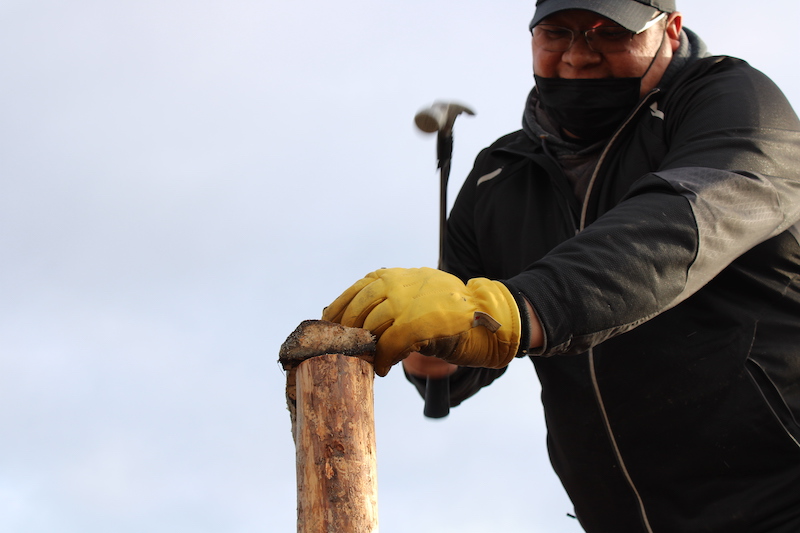As the first artist brought into the first school to host the Mikw Chiyâm interdisciplinary arts program, Mistissini’s Voyageur Memorial High School back in 2015, Chris Robertson has a deep understanding of the initiative’s impressive growth and enduring significance.
After facilitating screen printing arts residencies in almost every community, Robertson took the next natural step and became the full-time Mikw Chiyâm teacher in Chisasibi last fall. Back in Montreal, he would find himself eagerly waiting to return to the Cree Nation that now feels like home.
“The most asked question for any new teacher is, ‘Are you coming back?’,” Robertson told the Nation. “I get asked that question every day by students. The answer is yes. Before I started doing the residencies, I had never taught anything or at least I didn’t think I had that skill within me.”
Early experiences in Mistissini and Chisasibi revealed he had far more to teach than printmaking, such as life lessons that have made an impact with students. As the innovative program steadily expanded into each Cree community, a growing network of returning artists is similarly invested in youth success.
“A lot of my personal work became advocating for things they care about,” said Robertson. “One of the benefits of being around so long is seeing the students grow up. It’s always a good intention coming from down south that I’m trying to work myself out of a job. The idea that some students I’ve taught are now in a position to do that is the most beautiful thing.”
While Mistissini’s Angel Baribeau is the most notable example of a Cree student realizing their dreams through Mikw Chiyâm, several other students have also come full circle through the program to become artists-in-residence.
“The most important thing is that everyone tries to participate even if it’s not their thing,” Robertson asserted. “Painting is very popular, same with music, but there wouldn’t necessarily be a lot of crossover. Some have never spraypainted before in their lives, so if they can be free with it, you see a lot of joy in those moments that’s very rewarding.”
Although a new school building is being built, the materials James Bay Eeyou School has accumulated over several years of the program enable students to easily pursue projects in any artistic medium for their final term. Student input has shaped not only the program’s evolution but also the physical layout of the classroom.

“One of the most important things for me as a teacher is that when they walk in, they feel this is their class and they feel comfortable,” Robertson explained. “It feels like a safer space from the rest of the school. We have one large table where everyone sits together. We also have a chill zone in a quiet corner – whatever is comfortable for them to access the lesson.”
Mikw Chiyâm facilitators aim to nurture a supportive and respectful environment, encouraging creativity to bloom as students make friends during collaborative projects. Artists like Peatr Thomas, who will be teaching mural painting in his upcoming residency, find it particularly fulfilling when students choose to continue practicing these skills at home.
“Some of the youth have really taken to the skills I’ve passed on, painting with layers and being resourceful,” Thomas told the Nation. “Some practice at home – if they have that connection, they’re able to express themselves in a fun way. I just say have fun with it, don’t pressure yourself. Art teaches you it’s okay to make mistakes and try again.”
Before Christmas, students were learning photography techniques with artist Steve Haining. With the guiding question “where is my pride”, students were able to sign out professional digital cameras to explore images of their camp, cultural activities – wherever their inspiration took them.
“It’s been a beautiful journey for them,” Robertson remarked. “They’re learning in the moment. I like the idea of the guiding question, that we spend time before we make things thinking about our intention behind our work so we can put more meaning into it and communicate better with our art.”
A Mikw Chiyâm highlight has always been the year-end festival, when students from all over the Cree Nation would gather in Chisasibi to share their work and reconnect with the visiting artists. But that hasn’t been possible during the pandemic.
“It’s important for them to finish the year by showing their art and have that fun art trip together,” shared Robertson. “There are a lot of things that we used to do but the pandemic has made it difficult, and that’s the social aspect.”
While Robertson’s previous experience with Mikw Chiyâm simplified his transition, becoming a full-time teacher in a new community isn’t easy in the best of times. Coordinating the schedules of about 70 students from Secondary 1 to 5 is a challenging administrative task, especially with in-person classes delayed since the new year.
“With the hybrid model, some grades are here in school, some are at home,” explained Robertson. “We end up teaching in-person and online with me in the classroom and the artist in isolation, so there’s a lot of moving parts. I’m learning the hard way, learning through my mistakes.”
These last few months were even harder for students, but Mikw Chiyâm helped maintain a sense of community. Originally intended to increase student retention and motivation, the pandemic has reinforced how artistic expression can give life meaning.
“If that is the motivation for them to come to school and their other classes and friends, it helps build things back to the way it was before the pandemic,” suggested Robertson. “The skill we teach is taking that pressure in their brains and getting it outside of them through art. Art is a very powerful medicine.”





